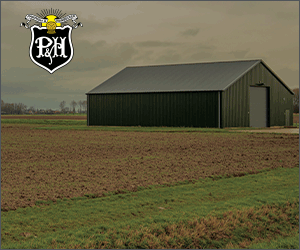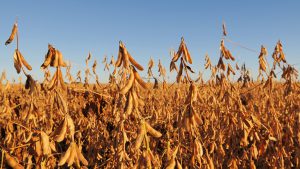From glass to grain
HIRAM WALKER AND SONS' ONTARIO SUCCESS

SINCE SETTING UP shop on the banks of the Detroit River back in 1858, the Hiram Walker and Sons Ltd. distillery has used locally-sourced Ontario grains as the backbone of their whiskies. It’s what they call a “grain to glass” approach — and one that’s brought them national and international acclaim.

Just recently, Hiram Walker and Sons was crowned Distillery of the Year at the eighth annual Canadian Whisky Awards. In addition, J.P. Wiser’s 35-Year-Old — produced at Hiram Walker’s Windsor distillery — won Canadian Whisky of the Year.
John Malott is the North American category manager for commodities and wet supplies for French beverage giant Pernod Ricard, the parent company of Hiram Walker and Sons Ltd.
The procurement team is responsible for sourcing and buying all the essential, raw ingredients needed for the distillery to operate. This includes barley, corn, wheat, and rye from across Ontario.
“At Hiram Walker, we think people like knowing that the product in their hands came from a farm,” says Malott. “And we’re proud to say that we’re locally sourcing as much as we possibly can and supporting the Ontario farm community.”
LOCAL GRAIN
The distillery buys over 100,000 metric tons of grain per year, with the majority being No. 2 yellow corn from Essex and Kent Counties.
Hiram Walker sources their grains through a large broker and elevator network and has also made several deep connections with local growers that are long-time suppliers.
“We’ve got certain farmers — particularly within the Essex County area — that have been multi-generation corn suppliers of Hiram Walker,” says Malott. “Their fathers, grandfathers, and great-grandfathers grew corn for us.”
Once the grain is sourced and purchased, it’s processed and distilled into spirits, such as whisky and vodka. In Canada, grains are distilled separately to preserve their individual flavour characteristics, then put in barrels to age for a minimum of three years.
According to Malott, corn is an essential ingredient in producing smooth Canadian
whisky, as it provides a sweet, mellow flavour. Barley, meanwhile, has a bold, nutty taste that’s highly effective in small doses.
Wheat lends whiskies what Malott describes as a soft, gentle “baked goods” flavour, and is a grain that is returning to Hiram Walker’s repertoire. In fact, the distillery worked with Grain Farmers of Ontario three years ago on a project to incorporate Ontario wheat into new whisky products.
“At the time, we weren’t distilling a lot of wheat — we were heavily into corn and had a little bit of rye and barley — but we wanted to look for that next grain coming down the pipeline,” says Malott.
He adds that the wheat spirit Hiram Walker began aging three years back shows potential but isn’t quite ready for it’s big debut. Rather, it’s at the start of a painstaking evaluation process that every new product goes through.
“We’re looking mainly at the taste and smell of the product,” he explains. “While the wheat spirit may be shaping up well right now, we’re confident that it will get better with time — we just have to find that barrel-aging sweet spot.”
Hiram Walker is also starting to experiment with oats as a potential new flavour. Though, as Malott points out, it’s still early days in determining whether the oats will distill well or yield a successful product.
“That’s part of the fun with grains we’ve never tried before — you mash them up, distill them and see what you get,” he says. “And different methods of distillation might yield different flavours depending on the grain.”
One grain where Hiram Walker has seen growth is rye.
“Over the past five or six years, there has been an increased consumer interest in the more rye-forward whiskies,” says Malott. “Rye has an assertive, spicy flavour that leaves you with that tingly, warming sensation in your chest.”
To meet long-term consumer demand, Hiram Walker worked with C & M Seeds in Palmerston and selected a hybrid rye variety that provided spicy, bold flavours, and a consistent, distilled spirit. The distillery has also developed an IP program aimed at getting Ontario farmers interested in growing speciality rye hybrids for the future.
PROCESSING
Besides buying and sourcing grains for their current and upcoming products, another major job for the Hiram Walker team is to refine how the grains are processed and prepared for distillation.
Malott points to how the distillery used to buy whole barley that was harvested, dried down, and shipped with the whole hull intact. Dr. Don Livermore, Hiram Walker’s master blender, suspected that the hulls were producing an “off” taste that didn’t sit well.
This led the distillery to work with a supplier in Waterloo Region that provides a de-hulled pot barley variety for a consistent flavour — but with none of the sour notes.
“We’re discovering more and more that the process around the grains can be just as important as the grains themselves,” says Malott. “And it’s also a value-added proposition to Ontario processors.”
Hiram Walker is also staying focused on future flavour trends by talking to growers, grain brokers, and seed dealers about the up-and-coming grain varieties that could hold the key to a successful new product.
“We know that certain characteristics that we may be looking for — or may not even know about — can come from flavour compounds within the grain,” explains Malott. “We’ll get recommendations, start distilling in small batches, and — if all goes well — start scaling things up.” •



























